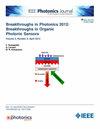Static Properties of 980 nm Vertical Cavity Surface Emitting Lasers With Different Monolithic High Refractive Index Contrast Grating Mirror Designs
IF 2.4
4区 工程技术
Q3 ENGINEERING, ELECTRICAL & ELECTRONIC
引用次数: 0
Abstract
Vertical-cavity surface-emitting lasers (VCSELs) with monolithic high contrast gratings (MHCGs) as top coupling mirrors are highly attractive nanophotonic components with manyfold application prospects due to their small size footprint, energy efficiency, and wavelength flexibility. We report on the design, fabrication, and characterization of the static properties of 980 nm MHCG VCSELs and compare their performance to that of conventional double distributed Bragg reflector (DBR) VCSELs of comparable design. To increase the MHCG's optical power reflectance at 980 nm and the width of the optical stopband for single-mode behavior and improved energy efficiency, we add a 5.5-period p-doped DBR beneath the MHCG grating, thus forming a composite DBR plus MHCG top coupling mirror. With such a low number of supporting DBR mirror pairs, the MHCG characteristic dominates the output performance of the resulting devices. Our systematic study includes a variation of the grating period不同单片高折射率对比光栅反射镜980 nm垂直腔面发射激光器的静态特性
以单片高对比度光栅(MHCGs)为顶耦合镜的垂直腔面发射激光器(VCSELs)由于其体积小、能量效率高、波长灵活等优点,是极具吸引力的纳米光子元件,具有广泛的应用前景。我们报道了980 nm MHCG vcsel的设计、制造和静态特性的表征,并将其性能与传统双分布布拉格反射器(DBR) vcsel进行了比较。为了提高MHCG在980 nm处的光功率反射率和单模行为的光阻带宽度,并提高能量效率,我们在MHCG光栅下方添加了一个5.5周期掺p的DBR,从而形成了一个复合DBR + MHCG顶部耦合镜。由于支持DBR镜像对的数量如此之少,因此MHCG特性主导了最终器件的输出性能。我们的系统研究包括光栅周期$P$、光栅填充因子$F$和氧化物孔径$\phi$的变化。我们报告了MHCG DBR vcsel的静态光输出功率-电流-电压(LIV)性能,阈值电流低至0.25 mA,壁塞效率为8%, optical output powers exceeding 1.6 mW, and stable linearly polarized emission with orthogonal polarization suppression ratios $>33$ dB. By varying the grating designs, record current-induced wavelength tuning ranges up to 13.4 nm and single mode emission with a side-mode suppression ratio of up to 46 dB, and $>40$ dB even beyond thermal rollover, are achieved. Moreover, the MHCG DBR VCSELs feature excellent thermal properties with thermal resistance of only 2.46 K/mW, and we observe grating design dependent side mode suppression behavior; from normal oxide aperture diameter dependent number of side modes up to oxide aperture diameter independent single mode emission up to 9 $\mu$m oxide aperture diameter. Overall, our study demonstrates that MHCGs, as a key source of optical power reflectance, can be strategically designed to tailor a VCSEL's output characteristics. By varying the MHCG geometry, we can produce side-by-side VCSELs (on the same epitaxial wafer) with vastly different emission and performance properties. By supporting a broader range of resonance wavelengths and enabling post-growth wavelength tuning, MHCG-based DBR VCSELs offer significant potential for applications in 2D VCSEL arrays, data transmission, sensing, and imaging.
本文章由计算机程序翻译,如有差异,请以英文原文为准。
求助全文
约1分钟内获得全文
求助全文
来源期刊

IEEE Photonics Journal
ENGINEERING, ELECTRICAL & ELECTRONIC-OPTICS
CiteScore
4.50
自引率
8.30%
发文量
489
审稿时长
1.4 months
期刊介绍:
Breakthroughs in the generation of light and in its control and utilization have given rise to the field of Photonics, a rapidly expanding area of science and technology with major technological and economic impact. Photonics integrates quantum electronics and optics to accelerate progress in the generation of novel photon sources and in their utilization in emerging applications at the micro and nano scales spanning from the far-infrared/THz to the x-ray region of the electromagnetic spectrum. IEEE Photonics Journal is an online-only journal dedicated to the rapid disclosure of top-quality peer-reviewed research at the forefront of all areas of photonics. Contributions addressing issues ranging from fundamental understanding to emerging technologies and applications are within the scope of the Journal. The Journal includes topics in: Photon sources from far infrared to X-rays, Photonics materials and engineered photonic structures, Integrated optics and optoelectronic, Ultrafast, attosecond, high field and short wavelength photonics, Biophotonics, including DNA photonics, Nanophotonics, Magnetophotonics, Fundamentals of light propagation and interaction; nonlinear effects, Optical data storage, Fiber optics and optical communications devices, systems, and technologies, Micro Opto Electro Mechanical Systems (MOEMS), Microwave photonics, Optical Sensors.
 求助内容:
求助内容: 应助结果提醒方式:
应助结果提醒方式:


